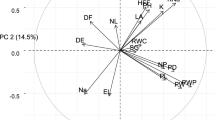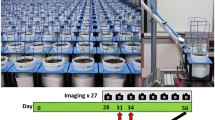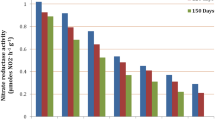Abstract
Six hundred accessions of chickpea (Cicer arietinum L.) landraces and its wild relatives from 28 different countries, available at Australian Temperate and Field Crops Collection (ATFCC) were screened for tolerance to salt under greenhouse conditions using three sampling strategies; (1) random sampling of 200 accessions from different countries, (2) restricted random sampling of 200 accessions from geographical regions with salinity problems and high diversity (Middle East and West & South Asia) and (3) as for strategy 1 but with a reduced representation of accessions from the geographical regions used in strategy 2. Degree of salt tolerance was based on necrosis scores and shoot biomass reduction relative to unstressed controls at harvest after subjecting stressed plants to salt treatment from 21 to 42 days after sowing. There was a wide variation in salinity tolerance determined by both measures. For sampling strategies 1, 2 and 3 respectively; 24, 28 and 14% of accessions were salt tolerant. Accessions from the middle east and south Asian (regions with salinity problem, a long history of chickpea cultivation and high diversity) gave a higher probability (P < 0.01) of getting salt tolerant accessions.

Similar content being viewed by others
References
Abdel Ghaffar AS, El-Attar HA, El-Halfaw MH, Abdel-Salam AA (1982) Effects of inoculation, nitrogen fertilizer, salinity, and water stress on symbiotic N2 fixation by Vicia faba and Phaseolus vulgaris. In: Graham PH, Harris SC (eds) Biological nitrogen fixation technology for tropical agriculture. CIAT, Cali, Colombia, pp. 72–82
Bayuelo-Jimenez S, Debouck DG, Lynch JP (2002) Salinity tolerance in Phaseolus species during early vegetative growth. Crop Science 42:2184–2192
Bedgegood W. and Bedggood A (2003) Victorian winter crop summary 2003. Department of Primary Industries (DPI). Horsham, Victoria, Australia (ISBN 174106 399X)
Ben-David R, Abbo S (2005) Phenological variation among Israeli populations of Cicer judaicum Boiss. Aust J Agri Res 56:1219–1225
Berger J, Abbo S, Turner NC (2003) Plant genetic resources: ecogeography of annual wild Cicer species – the poor state of the world collection. Crop Science 43:1076–1090
Berger JD, Buck R, Henzell JM, Tuner NC (2005) Evolution in the genus Cicer- vernalisation response and low temperature pod set in chickpea (C. arietinum L.) and its annual wild relatives. Aust J Agri Res 56:1191–1200
Bretag T, Meredith K, Knights T, Pittock C. and Materne M (2003) Control of ascochyta blight in chickpeas using resistant varieties and foliar fungicides. In: Solutions for a new environment. Proceedings of 11th Australian Agronomy Conference: Geelong, Australia, 2–6 February 2003. Available from http://www.regional.org.au/au/asa/2003/p/3/meredith.htm (accessed December 2006)
Coons JM, Pratt RC (1988) Physiological and growth responses of Phaseolus vulgaris and P. acutifolius when grown in fields at two levels of salinity. Annu Rep Bean Improv Coop 31:88–89
Datta KS, Dayal J, Goswami CL (1987) Effect of salinity on growth and yield attributes of chickpea (Cicer arietinum L.). Ann Biol 3:47–53
Dua RP (1992) Differential response of chickpea (Cicer arietinum) genotypes to salinity. J Agri Sci (Cambridge) 119:367–371
Dua RP, Sharma PC (1995) Salinity tolerance of Kabuli and desi chickpea genotypes. Inter Chickpea Pigeonpea Newslett 2:19–22
Foolad MR, Lin GY (1997) Absence of a genetic relationship between salt tolerance during seed germination and vegetative growth in tomato. Plant Breed 116:363–367
Frankel OH, Brown AHD (1984) Plant genetic resources today: a critical appraisal. In: Holden J.H.W., Williams J.T. (eds) Crop genetic resources: conservation and evaluation. Allen and Unwin, Winchester, Massachusetts, pp. 249–268
Ghassemi JN, Ghassemi F, Nix HA, Jakeman AJ (1995) Salinisation of land and water resources: human causes, extent, management and case studies. University of New South Wales Press Ltd, Australia and CAB International, United Kingdom, pp. 127–501
Joshi S, Nimbalkar JD (1983) Effect of salt stress on growth and yield in Cajanus cajan L. Plant and Soil 74:291–294
Krishnamurthy L, Kashiwagi J, Upadhyaya HD (2003) Genetic diversity of drought-avoidance root traits in mini-core germplasm collection of chickpea. Inter Chickpea Pigeonpea Newslett 10:21–24
Ladizinsky G (1998) Plant evolution under domestication. Kluwer Academic Publishers, Dordrecht, pp. 174–176
Loss S., Brandon N., and Siddique K.H.M (eds) (1998) The chickpea book – A technical guide to chickpea production. Bulletin 1326. Agriculture Western Australia. 76 pp
Lowry R (1998) Vassar Stats – The confidence interval of a proportion. Available from http://www.faculty.vassar.edu/lowry/VassarStats.html (accessed June (2006))
Luo Q, Yu B, Liu Y (2005) Differential sensitivity to chloride and sodium ions in seedlings of Glycine max and G. soja under NaCl stress. J Plant Physiol 162:1003–12
Maher L., Armstrong R. and Connor D (2003) Salt tolerant lentils–a possibility for the future? In: Solutions for a new environment. Proceedings of 11th Australian Agronomy Conference: Geelong, Australia, 2–6 February (2003). Available from http://www.regional.org.au/au/asa/(2003)/c/17/maher.htm (accessed June (2006))
Moreno-Limon S, Maiti RK, Foroughbakhch R (2000) Genotypic variability in Phaseolus bean cultivars exposed to salinity at the germination stage. Crop Res 19:487–492
Munns R, Hussain S, Rivelli AR, James RA, Condon AGT, Lindsay MP, Lagudah ES, Schachtman DP, Hare RA (2002) Avenues for increasing salt tolerance of crops, and the role of physiologically based selection traits. Plant and Soil 247:93–105
Munns R, James RA (2003) Screening methods for salinity tolerance: a case study with tetraploid wheat. Plant and Soil 253:201–218
Newcombe RG (1998) Two-Sided confidence intervals for the single proportion: comparison of seven methods. Stat Med 17:857–872
Nuttall J, Armstrong R, Connor D (2003): The effects of salinity, sodicity and soluble boron on wheat yields in the Victorian southern Mallee. In: Solutions for a new environment. Proceedings of 11th Australian Agronomy Conference: Geelong, Australia, 2–6 February (2003). Available from http://www.regional.org.au/au/asa/(2003)/c/17/nuttall.htm (accessed June (2006))
Peeters JP, Wilkes HG, Galwey NW (1990) The use of ecogeographical data in the exploitation of variation from gene banks. Theor Appl Genet 80:110–112
Ren ZH, Gao JP, Li LG, Cai XL, Huang W, Chao DY, Zhu MZ, Wang ZY, Luan S, Lin HX (2005) A rice quantitative trait locus for salt tolerance encodes a sodium transporter. Nat Genet 37:1141–1146
Rengasamy P (2002) Transient salinity and subsoil constraints to dryland farming in Australian sodic soils: an overview. Aust J Exper Agri 42:351–361
Rumbaugh MD, Pendery BM (1990) Germination salt resistance of alfalfa (Medicago sativa L.) germplasm in relation to subspecies and centers of diversity. Plant and Soil 124:47–51
Saxena NP, Saxena MC, Ruckenbauer P, Rana RS, E-Fuoly MM, Shabana R (1994) Screening techniques and sources of tolerance to salinity and mineral nutrient imbalances in cool season food legumes. Euphytica 73:85–93
Serraj R, Krishnamurthy L, Upadhyaya HD (2004) Screening chickpea minicore germplasm for tolerance to soil salinity. Inter Chickpea Pigeonpea Newslett 11:29–32
Spagnoletti Zeuli PLIand Qualset CO (1993) Evaluation of five strategies for obtaining a core subset from a large genetic resource collection of durum wheat. Theor Appl Genet 87:295–304
Toker C (2005) Preliminary screening and selection for cold tolerance in annual wild Cicer species. Genet Resour Crop Evol 52:1–5
Uitenbroek DG (1997) SISA Quantitative skills tables. Southampton: D.G. Uitenbroek.http://www.quantitativeskills.com/downloads/#Tables (accessed June (2006))
Upadhyaya HD (2003) Geographical patterns of variation for morphological and agronomic characteristics in the chickpea germplasm collection. Euphytica 132:343–352
Vadez V., Krishnamurthy L., Gaur PM, Upadhyaya HD, Hoisington DA, Varshney RK, Turner NC, Siddique KHM (2006) Tapping the large genetic variability for salinity tolerance in chickpea. Proceedings of the13th Australian Agronomy Conference, Australian Society of Agronomy, 10–14 September (2006), Perth, Western Australia. Available from http://www.regional.org.au/au/asa/(2006)/concurrent/environment/4561_vadez.htm (accessed December (2006))
Van Hintum Th JL, von Bothmer R, Visser DL (1995) Sampling strategies for composing a core collection of cultivated barley (Hordeum vulgare s. lat.) collected in China. Hereditas 122:7–17
Acknowledgements
We are grateful for Melbourne Research Scholarship (MRS) and pulse products project of Department of Primary Industries (DPI) Horsham, Victoria (Australia) and a study scholarship by Bunda College–NORAD Project (Malawi). We are also grateful to Gabriela Borgognone (DPI –Horsham) for advice on experimental design and statistical analysis.
Author information
Authors and Affiliations
Corresponding author
Rights and permissions
About this article
Cite this article
Maliro, M.A., McNeil, D., Redden, B. et al. Sampling strategies and screening of chickpea (Cicer arietinum L.) germplasm for salt tolerance. Genet Resour Crop Evol 55, 53–63 (2008). https://doi.org/10.1007/s10722-007-9214-9
Received:
Accepted:
Published:
Issue Date:
DOI: https://doi.org/10.1007/s10722-007-9214-9




